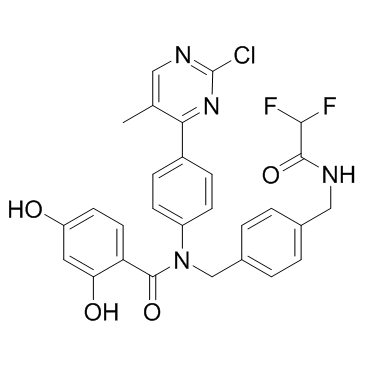VER-246608 |
| Catalog No.GC32778 |
A pan-PDHK inhibitor
Products are for research use only. Not for human use. We do not sell to patients.

Cas No.: 1684386-71-7
Sample solution is provided at 25 µL, 10mM.
VER-246608 is a potent and ATP-competitive inhibitor of pyruvate dehydrogenase kinase (PDK) with IC50s of 35 nM, 40 nM, 84 nM, and 91 nM for PDK-1, PDK-3, PDK-2, and PDK-4, respectively.
VER-246608 is a novel pan-isoform ATP competitive inhibitor of PDK. VER-246608 demonstrates similar potency across all four PDK isoforms in a DELFIA-based enzyme functional assay in the sub 100 nM range. In terms of cellular biomarker modulation, VER-246608 suppresses the phosphorylation of the Ser293 residue of E1α (phosphorylated by all four PDK isozymes) with IC50 values of 266 nM. Treatment of PC-3 cells with 9 μM and 27 μM VER-246608 results in a 21% and 42% reduction, respectively, in media L-lactate levels following a 1 h incubation. VER-246608 also decreases D-glucose consumption at the same concentrations that result in reduced L-lactate production. An approximately 50% reduction in spheroid volume is achieved at concentrations of 10 μM and above, suggesting an increase in VER-246608 potency compared to monolayer growth[1].
[1]. Moore JD, et al. VER-246608, a novel pan-isoform ATP competitive inhibitor of pyruvate dehydrogenase kinase, disrupts Warburg metabolism and induces context-dependent cytostasis in cancer cells. Oncotarget. 2014 Dec 30;5(24):12862-76.
Average Rating: 5 (Based on Reviews and 31 reference(s) in Google Scholar.)
GLPBIO products are for RESEARCH USE ONLY. Please make sure your review or question is research based.
Required fields are marked with *




















